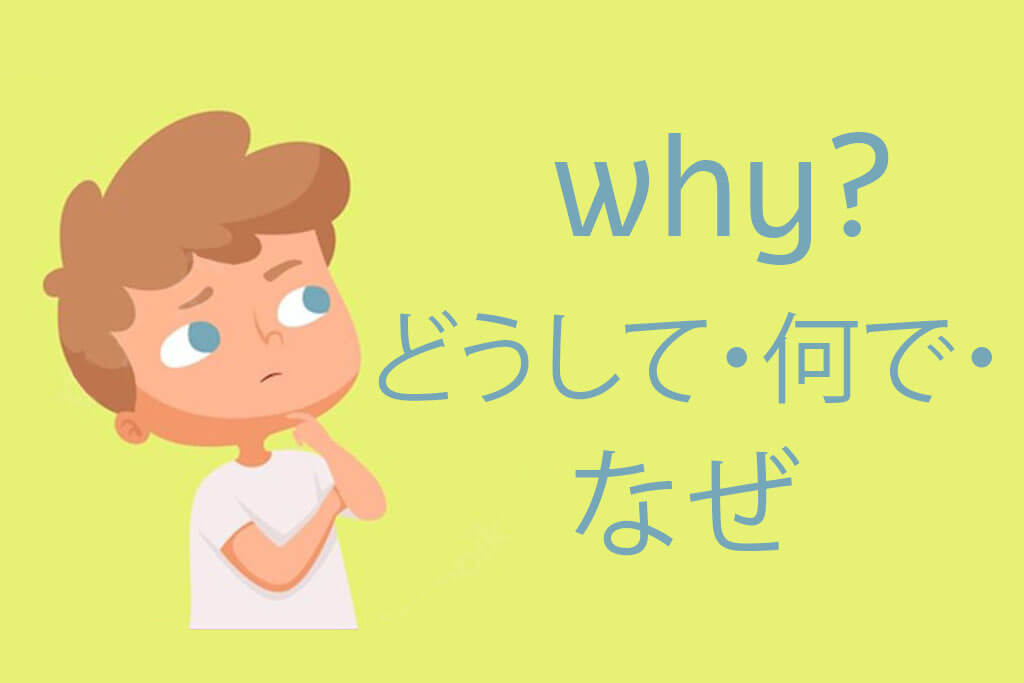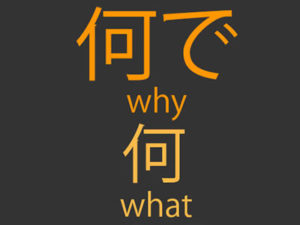There are three main ways to say “why” in Japanese. They are:
- 何で (nande).
- どうして (doushte).
- なぜ (naze).
These three words all mean “why” in Japanese and can be used when enquiring about the cause, reason, or purpose of something.
However, they each have specific differences and it’s important to be able to distinguish between them.
Generally speaking, 何で (nande) is mostly informal. It’s best used when speaking with friends.
どうして (doushte) can be either formal or informal. However, it is a slightly more ‘weighted’ way of asking someone “why”, meaning that you convey a little more emotion when you use it.
The third word, なぜ (naze) is a formal way of saying “why” in Japanese. You’ll mainly see it appear in academic writing, books, poetry, song lyrics etc.
With that said, there are other ways to say “why” in Japanese, as well as other nuances attached to the three words listed above. Although these three are certainly some of the most commonly appearing expressions.
In this ultimate guide, you can find a list of all of the ways to say “why” in Japanese, coupled with explanations, examples and native audio for your pronunciation reference.
Table of Contents
Why in Japanese
- Why.
何で。
nande.
The word 何で (nande) is one of the best ways to say “why” in Japanese.
It is mostly an informal way of asking “why” and should be used primarily when speaking with friends, family members, or those who are on the same ‘social’ level as you, such as a same-grade classmate.
You can use 何で (nande) to ask about the case, purpose or reason for something.
It is very similar to the English word for “why”. Just like the English word, you often place 何で (nande) at the beginning of a sentence when asking “why”.
How to say Why in Japanese with Examples
For instance:
- 何で日本語を勉強してる?
nande nihongo wo benkyou shteru?
Why are you studying Japanese?
Essentially, place 何で (nande) at the beginning of a sentence when you wish to compose a “why” question.
Should context allow it, you can also use 何で (nande) by itself to ask “why” to something, just like you would in English.
Let’s say you’re with a friend at a restaurant you’re ordering food. They tell the waiter that they’ll just have water for their drink when you’re expecting them to order some alcohol with you. You may ask them:
- え、何で? お酒飲まないの?
e nande? osake nomanai no?
Huh, why? Aren’t you going to drink any alcohol?
Related: How to say No in Japanese [Ultimate Guide].
Despite being a casual word, you may still hear 何で (nande) during formal speech. This is considered a little impolite (even if you attempt to make it formal by attaching ですか (desuka) to the end of the word. This would make it 何でですか (nande desuka).
Attaching ですか (desuka) transforms a sentence or phrase into a formal question. However, due to the nuances of 何で (nande), it still remains somewhat impolite even when it’s 何でですか (nande desuka).
Therefore you should avoid using 何で (nande) when speaking formally.
Use a different word (such as どうして (doushte), explained below) when you wish to ask “why” something in Japanese.
Why in Hiragana
The hiragana for 何で (nande), meaning “why” in Japanese, is なんで (nande).
As 何で (nande) is a casual word, you can write it in either hiragana or kanji as both are considered to be natural.
何で (nande) is commonly used in daily casual conversation, although you may find yourself writing (or typing) it when messaging a friend. During these situations writing 何で (nande) in hiragana is perfectly fine.
Why in Japanese Kanji
何で (nande) is a way to say “why” in Japanese that has a kanji. This kanji is 何 and means “what”. The kanji by itself is read as なに (nani), meaning “what” in Japanese.
Therefore, when you wish to ask “why” make sure that you include the で (de) that follows after 何 (nani). Otherwise, the meaning will change to “what”.
More Ways to Say Why in Japanese
- Why.
どうして。
doushte.
The word どうして (doushte) is the second of the three most common ways to say “why” in Japanese.
Unlike 何で (nande), どうして (doushte) can be used for both formal and informal speech.
However, when you use どうして (doushte) you’re asking with more ‘weight’ with your words. In other words, using どうして (doushte) communicates a little more emotion when you ask “why”.
You can use どうして (doushte) in many similar situations as you can 何で (nande) – to ask a for a reason, purpose or cause.
Generally, you place it at the beginning of the sentence, the same way as you would when asking “why” in English.
For instance:
- どうして泣いてるの?
doushte naiteru no?
Why are you crying?
As mentioned, どうして (doushte) carries a little more emotional impact. Therefore using どうして (doushte) to express extra emotion or concern can be useful.
It’s also important to note that, using the above sentence as an example, it is common to omit pronouns in Japanese.
If you are with someone who is crying, it’s obvious that you’re speaking to them when you ask them “why”.
For this reason, when the context is understood, it’s natural to drop the pronouns.
Related: How to say Happy in Japanese [Ultimate Guide].
The biggest difference between どうして (doushte) and なんで (nande) is that どうして (doushte) can also be used for formal speech.
For example:
- どうして何も言わなかったのですか。
doushte nanimo iwanakatta no desuka?
Why didn’t you say anything?
Just like 何で (nande), you place どうして (doushte) at the beginning of a sentence to compose a why question.
Why in Japanese Formally
- Why.
なぜ。
naze.
The word なぜ (naze) is a way to say “why” formally in Japanese with some specific usage.
First, it’s important to know that while なぜ (naze) is a formal word, it’s not formal in the sense that it’s polite. It sounds somewhat unnatural if you use なぜ (naze) when you wish to ask someone “why” in Japanese politely with Keigo (honorific language).
なぜ (naze) is a way to say “why” strictly in the formal sense – meaning that you’ll see it used mainly in academic essays, public speeches, books, song lyrics or poetry.
You don’t want to use なぜ (naze) when speaking with friends, for instance.
To ask a senior, a teacher, manager, stranger, (or customer if you’re staff) “why” formally/politely in Japanese, you should use どうして (doushte), explained above.
On the other hand, if you’re composing song lyrics, or writing a script for a speech or essay, なぜ (naze) is the best word to use.
Formal Why – Examples
For song lyrics, you have all the freedom to use なぜ (naze) how you wish:
- なぜいないの?
naze inai no?
Why aren’t you here?
There aren’t any restrictions on how you use なぜ (naze) in these types of scenarios, either.
- なぜ君は私のそばにいてくれないの?
naze kimi wa watashi no soba ni ite kurenai no?
Why won’t you be by my side?
Related: How to say I Like You in Japanese [Ultimate Guide].
Following the trend with 何で (nande) and どうして (doushte), なぜ (naze) can also be placed at the beginning of the sentence to make a “why” question.
Another way to understand なぜ (naze) is as a rational way to ask “why” in Japanese. Essentially, you can use it when you’re asking for the logic behind something. It can come across as considerably direct.
- なぜ君はお金を使い果たしたのか?
naze kimi wa okane wo tsukai hatashta no ka?
Why did you use up all the money?
In the above example, you’re seeking the logic behind an action. Remember, that なぜ (naze) is impolite when used in everyday conversation.
何で (nande), どうして (doushte), なぜ (naze) Difference
The three main ways to say “why” in Japanese, each has their own nuances and usage. This section serves as a summary of the most important differences between 何で (nande), どうして (doushte) and なぜ (naze) for your reference.
For a more detailed explanation and examples please see each individual listing above.
(1)
- 何で (nande)
The word 何で (nande) is a casual/informal way of saying “why” in Japanese. Using it with friends is the most natural way to use it.
It has a kanji that you may sometimes see. The kanji is 何 and means “what” in Japanese. Attaching で (de) makes it 何で (nande) and changes the meaning to “why”.
You can use 何で (nande) when speaking formally but should be avoided as it can appear impolite.
(2)
- どうして (doushte)
The word どうして (doushte) is both a casual and formal word. This means you can use it in more situations compared to 何で (nande), which is generally perceived as a casual word.
どうして (doushte) communicates more emotion when you use it to ask “why” in Japanese.
(3)
- なぜ (naze)
The word なぜ (naze) is a formal/rational way of saying “why” in Japanese. なぜ (naze) is not considered to be polite. Instead, it’s a formal way to ask “why”.
You primarily use it when writing academic pieces, essays, song lyrics, public speeches, poetry etc. Being a rational way of asking “why”, なぜ (naze) is best used to seek the logic or thought behind something.
It sounds unnatural to use なぜ (naze) when asking “why” to a friend.
Compared to どうして (doushte), なぜ (naze) carries no emotional context.
But Why in Japanese
- But why?
でも、何で/どうして?
demo nande/ doushte?
The literal translation for “but why” in Japanese is first to say でも (demo), and then follow it up with either 何で (nande) or どうして (doushte).
でも (demo) is a conjunction that means “but” in Japanese.
Just like in English, saying でも (demo) before asking 何で (nande) communicates an objection, uncertainty or confusion about something.
In English, we use “but” to introduce a word or phrase that contrasts with something. You use でも (demo) to do the same thing.
Sometimes we use the phrase “but why” to show that we’re seeking more information or an explanation. For example:
- でもどうしてパーティーに来なかったの?
demo doushte pa-tei ni konakatta no?
But why didn’t you come to the party?
Here, the speaker is asking for clarification on why the person didn’t come to the party.
Related: How to say I Don’t Know in Japanese [Ultimate Guide].
If you’re really wanting to know the reason behind something, you can communicate that feeling more directly, too.
- でもどうして! 理由を教えてよ。
demo doushte!– riyuu wo oshiete yo!
But why! Tell me the reason!
The above example is quite a strong way to express your feelings of wanting to know the truth. The person you’re speaking to will feel that too and will (hopefully) tell you their reasonings.
That’s Why in Japanese
- That’s why.
だから。
dakara.
The word だから (dakara) means “that’s why”, “therefore” or “so” n Japanese. You say だから (dakara) at the beginning of a sentence to explain a reason or purpose.
It works similar to “that’s why” in English and is a great way to respond to a question or statement to give your reasoning behind something.
For instance, if someone tells you that you look pretty tired, you might say something like:
- うん。だから帰ってから寝る。
un. dakara kaette kara neru.
Yeah. That’s why I’m going to sleep when I get home.
When you want to explain your past or future actions, だから (dakara) is a fantastic word to use.
As another example, imagine it’s snowing pretty hard and you’re late to class or work because of it. When you arrive someone mentions how the snow is pretty bad.
You may say:
- だから遅れたよ。
dakra okureta yo.
That’s why I was late.
So That’s Why in Japanese
You can also use だから (dakara) as a means to confirm a statement or to presume an answer to something.
For instance, perhaps yesterday a classmate or colleague went home unexpectedly early. Later, they tell you that they had a migraine that same day.
Similar to how we would say “so that’s why you…” in English, we can say:
- だから昨日早く帰ったの?
dakra kinou hayaku kaetta no?
So that’s why you went home early yesterday?
In the above example, we use だから (dakara) to explain the answer to something.
You use it when talking about past or future circumstances.
Imagine you have a friend on a super strict diet. You know they won’t touch chocolate or sweets at all! Or at least that’s what you thought until they tell you they want to buy 2 mars bars and 3 snickers bars.
You find out later that they are having a celebration. You may respond:
- だからチョコレートを買いたいんだ!珍しいと思ったよ。
dakra chocore-to wo kaitainda! mezurashii to omotta yo.
So that’s why you want to buy chocolate! I did think it was unusual for you.
Having just worked out the reasoning behind something, you express your findings or thoughts with だから (dakara).
Why Do you Ask in Japanese
Saying “why do you ask” in Japanese can be done one of two ways.
The first way simply involves using 何で (nande) as a response to somebody’s question. We learned that 何で (nande) is one of the ways that mean “why” in Japanese. But the words’ meaning and nuances can stretch to mean “why do you ask” also.
The second, and more literal way of asking someone, is to use:
- Why do you ask?
何で聞くの?
nande kiku no?
Note that this can come across as somewhat direct.
We know that 何で (nande) means “why” in Japanese.
The second word, 聞く (kiku) is a verb that means “to ask” or “to listen” in Japanese.
The final の (no) is an optional addition that adds a little more emotion to your words.
This sentence is a casual way of saying “why do you ask” in Japanese.
You can add more words to this phrase, too. For example, you can specify the matter or thing that the person is asking you about.
- 何でそれを聞くの?
nande sore wo kiku no?
Why do you ask that?
Just like in English, each phrase conveys slightly different nuances depending on which version you use.
Why Are You Asking?
You can use the template of this phrase to change it to a continuous phrase, too.
- Why are you asking?
何で聞いている?
nande kiite iru?
The word 聞いている (kiite iru) is the present continuous form of 聞く(kiku). This means that 聞いている (kiite iru) means “asking”, and 聞く(kiku) means “to ask”.
In English, we use the two phrases “why do you ask” and “why are you asking” somewhat interchangeably. In Japanese, this is similar.
The Reason Why Is… in Japanese
To give a reason for something using the phrase “the reason why is…” in Japanese, we have to use an N3 Grammar point.
There are two grammar points we can use to say this. They are:
(1)
- The reason why is…
なぜかというと…からだ。
naze ka toiu to… kara da.
And:
(2)
- The reason why is…/because.
なぜなら。
nazenara.
なぜかというと (naze ka toiu to) Japanese Grammar
なぜかというと (naze ka toiu to) is an N3 grammar point that quite literally translates to: “if I had to say why then…”
Out of the two phrases, なぜかというと (naze ka toiu to) is on the less-formal end of the scale.
The first part of this grammar is なぜか (naze ka), an adverb that means “somehow” or “for some reason” in Japanese.
Secondly, the という (toiu) that follows なぜか (naze ka) in なぜかというと (naze ka toiu to) is an expression verb that means “to say” in Japanese. Sometimes, you may see it written in kanji as と言う (to iu). To clarify, 言 is the kanji for “say” or “speak”.
The final と (to) is one of the four ways to say “if” in Japanese. Use this “if” to say that something is absolute if it happens. Use it to say things like:
- ボタンを押すとおつりがでる。
botan wo osu to otsuri ga deru..
If you push the button change will come out.
Just like in the example, you use と (to) to describe something that is definite or 99.9% expected.
In conclusion, the addition of the final と (to) at the end of なぜかというと (naze ka toiu to) adds an “if” nuance to the construction of this grammar point.
Breaking down the grammar point like this may help you understand it. However, it’s not always necessary.
Instead, it’s important to understand the entire phrase なぜかというと (naze ka toiu to) as a way to say “the reason why is…” in Japanese.
なぜかというと (naze ka toiu to) Examples
Place なぜかというと (naze ka toiu to) at the beginning of the sentence to compose a sentence that begins with “the reason why is”.
You use this grammar point when you wish to express a reason for something.
You can say things like:
- なぜかというと甘いものが好きだからです。
naze ka toiu to amaimono ga suki dakara desu.
The reason why is because I like sweet things.
When you use this grammar point to give a reason for something, you should end the sentence with から (kara).
The best way to understand から (kara) is to remember it as a way to say “because” in Japanese. By itself, から (kara) is an N5 beginner grammar point.
Remember that should the word preceding から (kara) be a na-adjective or noun, you need to include だ (da) between the word and から (kara).
To clarify, use なぜかというと (naze ka toiu to) when the item/thing you’re giving a reason or explanation for has already been mentioned.
Another example:
- なぜかというと疲れたからです。
naze ka toiu to tsukareta kara desu.
The reason why is because I was tired.
In this example, the reason is given because of something that happened in the past. なぜかというと (naze ka toiu to) is a tool you can use to introduce that reason/explanation.
For more information on how と (to) functions in this sentence, I recommend this video by Misa.
なぜなら Explanation
The second way to say “the reason why is” in Japanese is to use なぜなら (nazenara).
This is mostly a formal phrase, therefore is best used in such situations.
- なぜなら彼が招待したからです。
nazenara kare ga shoutai shta kara desu.
The reason why is because he invited me.
You also place なぜなら (nazenara) at the beginning of a sentence to introduce a reason or explanation for something.
Similarly, it’s important to include から (kara) at the end of the explanation/reason phrase to complete the sentence properly.
As mentioned, から (kara) is a beginner’s grammar point that means “because” in Japanese.
Why Not in Japanese
- Why not?
いいんじゃない?
iinjanai?
Use いいんじゃない (iinjanai) to say “why not” in Japanese. This phrase is fantastic to use as a response to encourage or prompt someone to do something.
If someone asks your opinion on if you think they should do something or not, you can use this phrase. In short, using いいんじゃない (iinjanai) is a way to express your approval of something.
An example conversation:
- ね、今夜のパーティーに行っていいかな?
ne, konya no pa-tei- ni itte ikana?
Hey, I wonder if it’s okay if I go to tonight’s party… (?)
In the above question, the person is seeking another’s opinion.
The response:
- うん。いいんじゃない?
un. iinjanai?
Yeah. Why not.
This phrase いいんじゃない (iinjanai) consists of three elements.
Firstly いい (ii) which means “good” in Japanese.
Related: How to say Good in Japanese [Ultimate Guide].
Secondly, ん (n) is an optional addition which makes the phrase more natural and somewhat more considerate.
ん (n) adds slightly more emotion to your words.
The final じゃない (janai) is an expression that you use at the end of a sentence. It has a few meanings. It functions as an expression that means “is not” or “am not” while also a tool that’s used to confirm the response being made.
I’ve written more about this word in detail in this guide: How to say No in Japanese [Ultimate Guide].
In short, じゃない (janai) is used to confirm information in the sense of “isn’t it”?. By attaching it to いい (ii), (meaning “good” in Japanese) we can understand いいんじゃない (iinjanai) to mean “good, isn’t it?” in a literal translation.
Note that this is a casual phrase, and should only be used between friends. To make it formal, attach ですか (desuka) to the end, making it:
- いいんじゃないですか。
iinjanai desuka.
Why not. (formal).
Why That Much? in Japanese
To emphasise an element of surprise when expressing “why” in Japanese, use the following phrase:
- Why that much?
何でそんなに?
nande sonna ni?
We know that 何で (nande) is one of the standard ways to say “why” in Japanese.
You can use そんなに (sonna ni) to express something that is a lot in quantity. A great way to understand そんなに (sonna ni) is to interpret it as “that much”.
For instance, we can form the sentence:
- 何でそんなに日本語を勉強したいの?
nande sonna ni nihongo wo benkyou shtai no?
Why do you want to study Japanese that much/badly?
A question that would certainly have many answers, indeed.
What makes you passionate about the Japanese language?
One of the reasons for me is The Legend of Zelda!
Looking at the original Japanese text of the Zelda games to uncover secrets and new insights into the lore and story is truly fascinating.
Join me on my YouTube channel where we delve into the Japanese versions of the Zelda games!
Want more How-To Japanese guides?
View all [Ultimate How-To Japanese Guides]
Recommended:
How to say Happy in Japanese [Ultimate Guide].
How to say Thank You in Japanese [Ultimate Guide].







